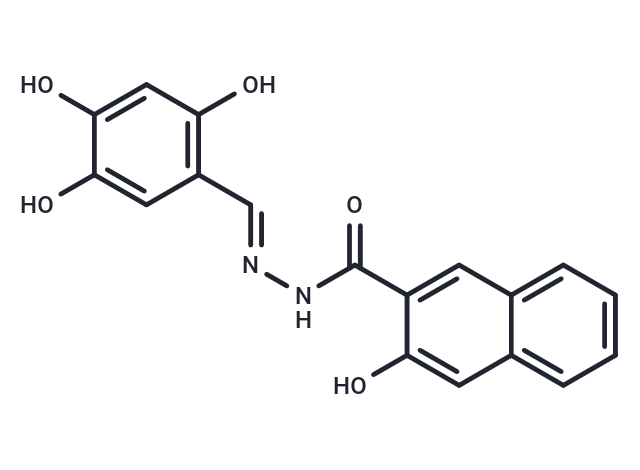Shopping Cart
Remove All Your shopping cart is currently empty
Your shopping cart is currently empty
Hydroxy-Dynasore (Dyngo-4a) , a effective dynamin inhibitor, inhibits withDynI (brain), DynI (rec), and DynII (rec) of IC50 of 0.38 μM, 1.1 μM, and 2.3 μM, respectively.

| Pack Size | Price | USA Warehouse | Global Warehouse | Quantity |
|---|---|---|---|---|
| 5 mg | $46 | In Stock | In Stock | |
| 10 mg | $76 | In Stock | In Stock | |
| 25 mg | $139 | In Stock | In Stock | |
| 50 mg | $233 | In Stock | In Stock | |
| 100 mg | $347 | In Stock | In Stock | |
| 200 mg | $516 | In Stock | In Stock | |
| 500 mg | $825 | Inquiry | Inquiry | |
| 1 mL x 10 mM (in DMSO) | $50 | In Stock | In Stock |
| Description | Hydroxy-Dynasore (Dyngo-4a) , a effective dynamin inhibitor, inhibits withDynI (brain), DynI (rec), and DynII (rec) of IC50 of 0.38 μM, 1.1 μM, and 2.3 μM, respectively. |
| Targets&IC50 | DynII (rec):2.3 μM, DynI (rec):1.1 μM, DynI (brain):0.38 μM |
| In vitro | Dyngo-4a inhibits dynamin-dependent endocytosis of transferrin in multiple cell types with IC?? of 5.7 μM, and reduces synaptic vesicle endocytosis and activity-dependent bulk endocytosis in cultured neurons and synaptosomes. [1] In motor nerve terminals and cultured hippocampal neurons, Dyngo-4a blocks Alexa Fluor 488-BoNT/A-Hc internalization. [2] In Drosophila S2R+ cells, Dyngo-4a causes a decrease in the level of Armadillo/β-catenin. [3] |
| Synonyms | Dyngo-4a |
| Molecular Weight | 338.31 |
| Formula | C18H14N2O5 |
| Cas No. | 1256493-34-1 |
| Smiles | Oc1cc(O)c(\C=N\NC(=O)c2cc3ccccc3cc2O)cc1O |
| Relative Density. | 1.45 g/cm3 (Predicted) |
| Color | White |
| Appearance | Solid |
| Storage | Powder: -20°C for 3 years | In solvent: -80°C for 1 year | Shipping with blue ice/Shipping at ambient temperature. | |||||||||||||||||||||||||||||||||||
| Solubility Information | DMSO: 45 mg/mL (133.01 mM), Sonication is recommended. | |||||||||||||||||||||||||||||||||||
| In Vivo Formulation | 10% DMSO+40% PEG300+5% Tween 80+45% Saline: 2 mg/mL (5.91 mM), Sonication is recommended. Please add the solvents sequentially, clarifying the solution as much as possible before adding the next one. Dissolve by heating and/or sonication if necessary. Working solution is recommended to be prepared and used immediately. The formulation provided above is for reference purposes only. In vivo formulations may vary and should be modified based on specific experimental conditions. | |||||||||||||||||||||||||||||||||||
Solution Preparation Table | ||||||||||||||||||||||||||||||||||||
DMSO
| ||||||||||||||||||||||||||||||||||||
| Size | Quantity | Unit Price | Amount | Operation |
|---|

Copyright © 2015-2025 TargetMol Chemicals Inc. All Rights Reserved.